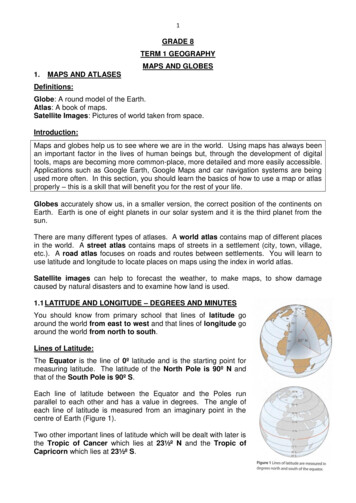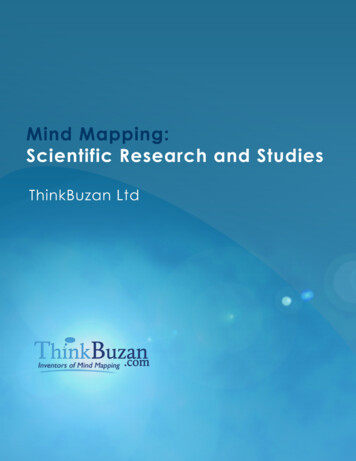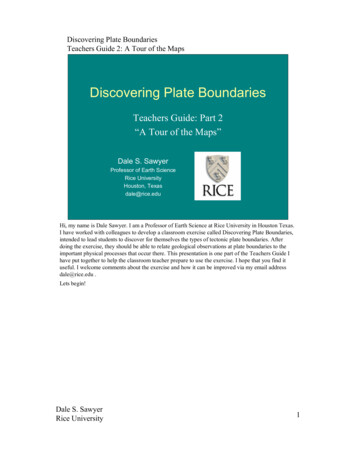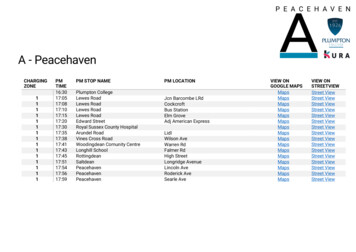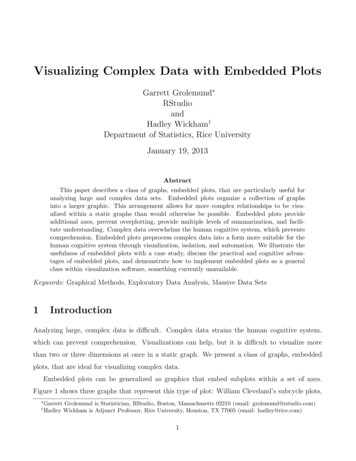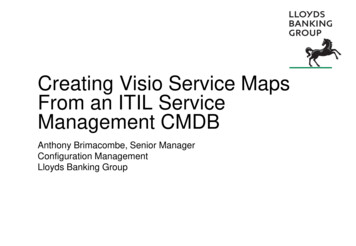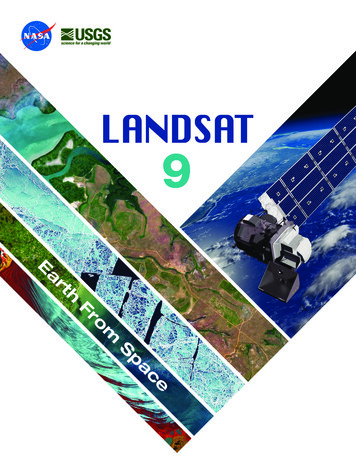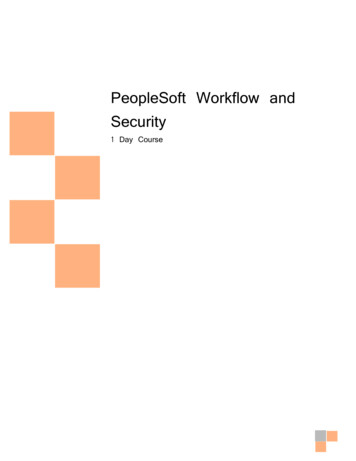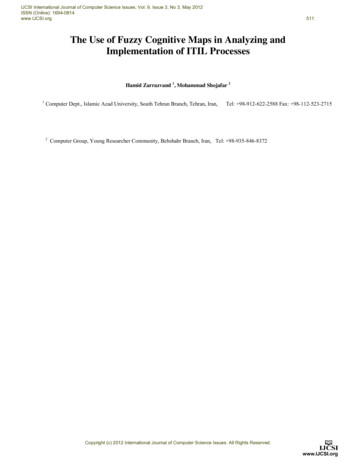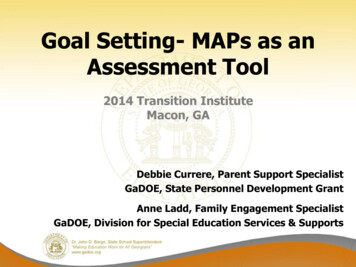
Transcription
Goal Setting- MAPs as anAssessment Tool2014 Transition InstituteMacon, GADebbie Currere, Parent Support SpecialistGaDOE, State Personnel Development GrantAnne Ladd, Family Engagement SpecialistGaDOE, Division for Special Education Services & Supports
Learning Targets for this SessionWill be able to:- summarize the benefits of using aperson-centered planning toolsuch as MAPS in transitionplanning.
-access the resources and technicalassistance for using person-centeredplanning that can provide furtheropportunities of greater knowledgeand use.9/29/20143
Person CenteredWhat is this all about?9/29/20144
Philosophies of PCP Supports a life lived on the individual’s terms– A living situation chosen in a desired community– A job that matches strengths and interests– Selected support staff Presume competence in a person’s dream Perceive behavior as communication9/29/20145
Core Elements of PCP The individual is the driving force The individual chooses those involved Individuals have gifts that provide a valued rolefor them in the community Individuals have the ability & desire to gain &maintain satisfying relationships Continual listening, learning and action will helpthe person get what he/she wants in his/her life9/29/20146
MAPSMaking Action Plans
MAP A group process for– Clarifying gifts– Identifying meaningful contributions– Specifying the necessary conditions forcontribution– Making agreements that will developopportunities for contribution A planning tool for 1 to 3 years9/29/20149
Telling the STORY The focus person recounts three briefmoments or stories from their past thatmatter at this moment.– Some questions to help the focus person: What can my past teach me about my gifts? Which moment in my recent past can teach meabout my gifts?9/29/201410
9/29/201411
Honoring the DREAM Explaining to the focus person that ourdreams tell us something important about– Who we are– Our purpose in life– What we are called to bring to our world, ourcountry, our community, our friends and family.“What is my dream, what do I reallywant for my life?”9/29/201412
9/29/201413
Recognizing the NIGHTMARE The nightmare speaks for what we wantto keep from becoming or an experiencewe want to find a way out of because theymake us feel trapped and/or powerless.9/29/201414
9/29/201415
Naming the GIFTS/CONTRIBUTIONS When you see this person at his/her best,what does he/she bring to others? Whatdoes he/she contribute? How does this person make a positivedifference? What makes this person’s eyes shine?9/29/201416
9/29/201417
What it TAKES What would it take for others to receivethis persons gifts?– Where in the community would the gift bewelcome?– What modifications to procedures, routineswill allow the gift to be given?– What role will best encourage the person toexpress the gift?9/29/201418
9/29/201419
Action AgreementsOrganizing whatever work may be necessary toarrange what it takes for this person to havethe opportunity to give his/her gifts.- Capture the ideas and then focus on 3-5,asking the focus person first if they agree.- Consider (Who/ What / by When)- The people to inform and involve- Opportunities to search for- Changes to negotiate for.9/29/201420
9/29/201421
MAPs have been used to: Determine some present levels based on theindividuals story. Establish goals for the transition plan.9/29/201422
The Stories . Age 15 Who else attended? High School principal,school counselor, Special Ed. Director, SundaySchool Teacher, grandmother and parents What were the 3 primary goals that surfaced?– Black Tie Tiger Club participation– Work with animals– Train to work at her father’s store where there is a“petting zoo”.9/29/201423
Another Story Age 19 Who else attended? Grandmother, ProjectSearch Instructor, CCDS, Hospital Mentor,GVRA, PS Job Coach, and parents What were the 3 primary goals that surfaced?– Obtain a driver’s license– Participate in and improve upon social skills inpeer group settings– Develop job skills & obtain employment9/29/201424
Another Story . Age 17 Who else attended? teachers, lead teacher,case manager, family What were the 3 primary goals that surfaced?– More independence at home– More inclusive activities in the community andschool– More Volunteer/Work experiences9/29/201425
Think about your ownLIFE .9/29/201426
9/29/201427
FAMILY CIRCLEName the people you love most and who love you most in the center circle, theplace of family life - people you trust the most, who know you best, who loveand care about you. PERSONAL NETWORKFamily, friends, neighbors, classmates, co-workers, church members, helpfulteachers (or other paid people).People you rely on, with whom you exchange friendship and concern, triumphs,struggles, mutual interests. COMMUNITY NETWORKAcquaintances, friends from the past, people who you mostly greet oracknowledge as part of your community life.1.Write each person’s name you know and care about on the map. Indicate the natureof the relationship by your placement. Ie: family, home support, work/school supportor friends.2.Indicate intensity & strength of the relationship by writing the name closer to thecenter. Highlight people in yellow who might be involved in your support circle.3.Look at your map. What do you notice? Do you see any patterns or themes?
Lessons LearnedAdapted fromExploringNew WorldsBy BethMount andConnie LyleO’Brien9/29/201429
Lessons Learned1. An effective transition is guided by apowerful image of how the student willcontribute to community life as an adult.This image emerges from knowing thestudent and his community and expands overtime through direct, real experience.2. Positive outcomes are not the result of aprivate planning process. They result fromtaking opportunities that involve manypeople.9/29/201430
Lessons Learned3. Ideas about life after graduation come asmuch from knowing the student’scommunity as they do from knowing thestudent.4. Teachers, students and parents must get outin the community with an eye towardvocational, volunteer, and membershipopportunities.9/29/201431
Lessons Learned5. Be willing to do things that have never beendone before. Consider the uniqueness of theparticular student.6. Create opportunities for people to sharetheir ideas with others. People’s ideasdeepen when they listen to other people’sstories as well as tell their own.9/29/201432
Lessons Learned7. Pay close attention to the ideas of parentsand students: they can be the mostimportant keys to possible futures.8. Support and encourage parents to contributein any way that they can and are willing tocontribute.9/29/201433
RESOURCES We have provided you with a resourcehandout. For information on finding a MAPS Facilitatorin your region, contactMs. Stacey Ramirez,Director of Individual and Family Support,Center for Leadership in Disability at GSUsramirez@gsu.edu9/29/201434
“Though no one can go backand make a brand new start,anyone can start from nowand make a brand newending.” – Anonymous
Learning Targets for this SessionLet’s review Will be able to:- summarize the benefits of using aperson-centered planning toolsuch as MAPS in transitionplanning.
-access the resources and technicalassistance for using person-centeredplanning that can provide furtheropportunities of greater knowledgeand use.9/29/201437
OUR CONTACT INFORMATIONDebbie CurrereParent Support SpecialistPioneer RESA/ North GA GLRSGaDOE State Personnel Development Grantdcurrere@pioneerresa.orgAnne LaddFamily Engagement SpecialistGaDOE, Division for Special Education Services & Supportsaladd@doe.k12.ga.us9/29/201438
Goal Setting- MAPs as an Assessment Tool 2014 Transition Institute Macon, GA Debbie Currere, Parent Support Specialist . Helping ensure that services support the youth’s goals and lead to successful outcomes; and Helping identify and cultivate natural suppo
